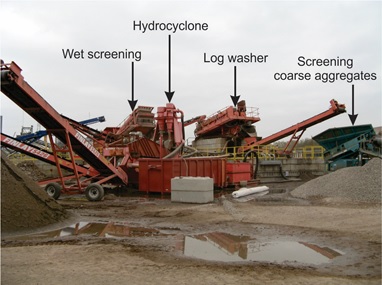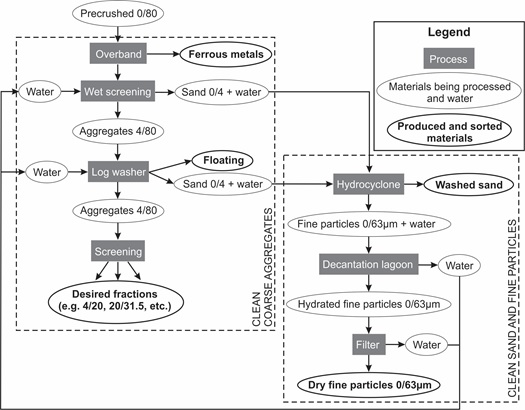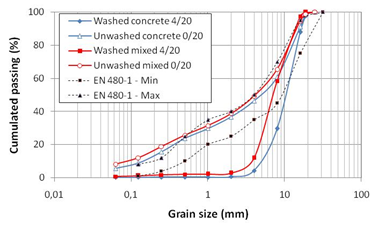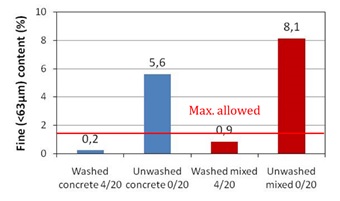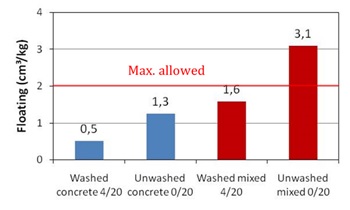Figure 4: Floating content in washed and unwashed recycled aggregates
Bulk and particle densities
The bulk density of both washed and unwashed aggregates respect the regulations. In fact, the bulk density of washed concrete and washed mixed aggregates 4/20 corresponds to 1.22 and 1.19 g/cm³ respectively, whereas the bulk density of washed concrete and washed mixed sands corresponds to 1.42 and 1.34 g/cm³ respectively.
Recycled concrete aggregates’ particle density ranges between 2.3 (unwashed) and 2.5 g/cm³ (washed) and recycled coarse mixed aggregates particles density varies between 2.1 (unwashed) and 2.4 g/cm³ (washed). In every case, the measured values of particle density are above the standard requirements in every investigated NWE countries. Indeed, the minimum particle density of concrete aggregates is defined at 2.0 or 2.2 g/cm³. These values move at 1.7 or 2.0 for mixed aggregates.
Washing is not required for the recycled aggregates to respect the regulations in term of bulk and particle densities. Note, however, that the measured values are lower than those usually characterizing natural aggregates. For reference, the particle density of sandstone is 2.6-2.65 g/cm³ and of limestone is 2.65-2.7 g/cm³.
Water absorption
The water absorption was measured on both sands and coarse aggregates. The general trends show that mixed fractions have higher water absorption than concrete samples. In fact, water absorption of concrete aggregates ranges between 6.0 and 6.3%. This parameter reaches 9.2% in mixed aggregates. Sandy fractions have lower water absorption for both concrete and mixed samples, with respectively 4.9 and 4.8%. Overall, washing has no influence on the water absorption of recycled aggregates. Nonetheless, the measured values were lower than the maximum values required in standards from Germany and Belgium. The maximum values of water absorption in concrete and mixed aggregates are defined at respectively 10% and 15% in standards from both countries.
Note, however, that measured values are much higher than those usually characterizing natural aggregates. Water absorption usually ranges between 1 and 1.5% in limestone and between 1 and 2% in sandstone.
Resistance to fragmentation
Resistance to fragmentation was measured through the Los Angeles test. The results show that no significant difference exists between washed and unwashed materials. Concrete aggregates have a Los Angeles coefficient of around 34 and 36, and mixed aggregates have values between 42 and 43. Thus, concrete aggregates have a higher resistance to fragmentation than mixed aggregates. The most restrictive standards in all of the partner countries set a maximum value of 35 for concrete aggregates and 50 for mixed aggregates. This means that the measured results are in agreement with the national standards. Note that Luxembourg does not define a value for mixed aggregates. Consequently, recycled mixed aggregates in Luxembourg are submitted to concrete recycled aggregates standard for which the maximum value is 40. The mixed aggregates’ resistance to fragmentation is therefore too low for Luxembourgish standards.
Conclusion
Washing significantly improves some properties of recycled aggregates. It also allows for the production of clean coarse aggregates with the smallest grain diameter higher than 0 mm (d>0mm). Moreover, Washing also decreases fine content and the amount of floating elements. This matters because fine content is the most constraining parameter for aggregates used in concrete, and washing brings fine content levels below the maximum values defined in the investigated national standards.
However, washing has less influence on the following parameters: particle density, water absorption, resistance to fragmentation, and the proportion of non-floating elements.

